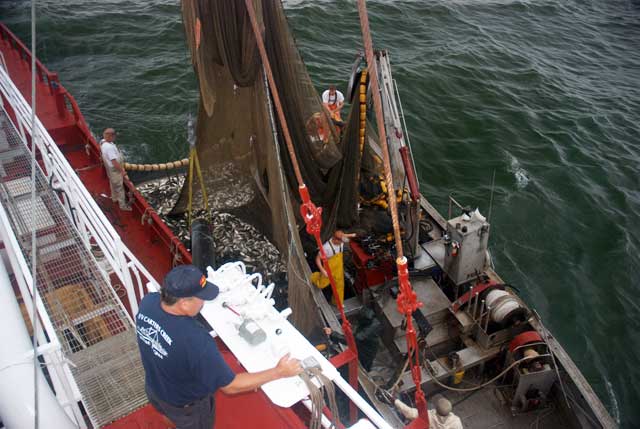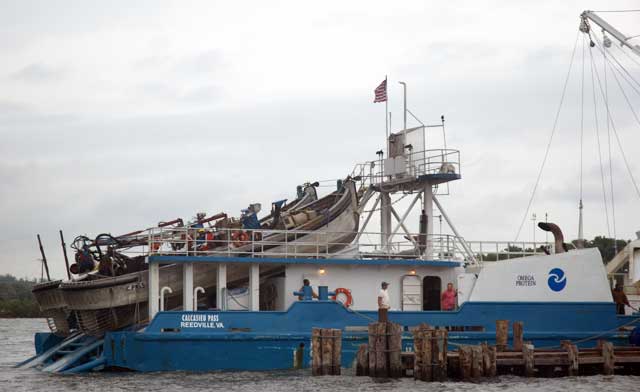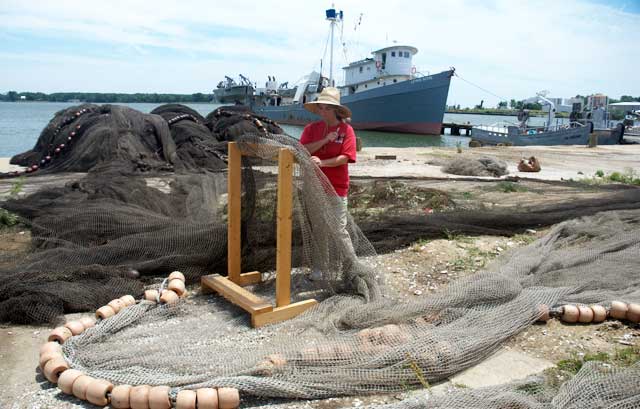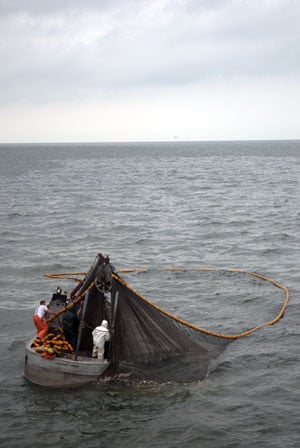Baitfish Wars: The Ongoing Fight Over Menhaden Management

Large motherships load menhaden into their holds before taking them to be processed.
Fans of “reality” television are undoubtedly familiar with Deadliest Catch, a program that chronicles the trials and triumphs of anglers who brave the frigid temperatures and unpredictability of the Bering Sea in pursuit of the deadliest catch, the Alaskan king crab. Indeed, commercial angling is not for the faint of heart: it is considered one of the most dangerous professions, in the practice of which anglers get little sleep, work long hours, often perform arduous and dangerous manual labor, and brave the elements on a daily basis.
Far from the Bering Sea, a storm is brewing that threatens to engulf a different species of commercial angler—and at the center of this storm lies the humble menhaden, an oily and inauspicious baitfish wholly unaware of its central role in this drama. Pitted against each other in this life-and-death struggle are giant fish processor Omega Protein and conservationists who believe that the company’s fishing practices spell the end of Atlantic coast menhaden.
Omega Protein, headquartered in Houston, Texas, is North America’s largest menhaden harvester. In Reedville, Virginia Omega Protein operates a reduction plant—so-called because after the menhaden are caught at sea, they are “reduced” or boiled down and their oil extracted for a number of products, which include paint additives, heart-healthy tablets, pet food, and, ironically, fish food for aquaculture. This reduction plant is central to the lifeblood of Reedville: It supports roughly 300 jobs in the industry and shells out about $40 million a year in operating expenses.
Now, Americans have been fishing for menhaden before the United States was born: Native Americans used the bony fish—which humans tend not to eat directly—as fertilizer for their crops. Eventually others got in on the act, harvesting thousands of pounds of menhaden from wooden ships by hand with standard nets. In the mid-1900s the fishing was so good that menhaden factories dotted the East Coast and nearly two dozen reduction operations thrived in states like Maine, Delaware, and North Carolina.

Smaller chase boats are mounted on the back of motherships, which deploy purse seine nets while menhaden fishing.
Times have changed, however, and today only Omega Protein’s Reedville plant is still standing. The company uses spotter planes, sophisticated electronics, “mother ships,” and “purse seine” nets, which close up from the bottom using a drawstring (such as one finds on a purse). Smaller chase boats deploy these nets when they locate a school of menhaden; the nets may capture as many as 10,000 menhaden in a single haul. These highly efficient methods have allowed Omega Protein to gather nearly a quarter of a billion tons of menhaden in a single season.
Insisting that menhaden are overfished and on the brink of collapse, conservationists point to “Little Fish, Big Impact,” a recent study by the Lenfest Forage Fish Task Force, a group of 13 eminent scientists from around the world who spent three years identifying the crucial role of saltwater baitfish. The study concludes that baitfish are overharvested by as much as 50 percent in some locations, and that they are worth twice as much as forage fish for larger predators as they are when commercially harvested.
Conservationists fear that overfishing leaves too few forage fish for striped sea bass, flounder, red drum, speckled sea trout, and tuna to eat. They add that avian predators like loons and ospreys and many other marine animals depend on menhaden for their survival. (Other studies indicate that similar baitfish species like American shad have also dwindled. Alewife and blueback herring—better known collectively as river herring—have experienced dramatic decline in recent years and are a mere a shadow of their former numbers.)
Menhaden management varies by state. Individual states manage the species from their coastline to three miles out from shore. The area from the three-mile limit to 200 miles offshore falls under the jurisdiction of the Atlantic States Marine Fisheries Commission (ASMFC) in an area known as the Exclusive Economic Zone. Beyond 200 miles offshore is considered international waters and is more or less common ocean property.
Created in 1942, the ASMFC is a consortium representing 15 states from Maine to Florida. As one might imagine, different states have different commercial and political interests. Maine, for example, may tend to be more lenient with lobster harvests, a business in which South Carolina may be uninterested. Massachusetts may wish to more closely regulate the striper harvest, whereas New Jersey sees no reason to do so. This form of management by committee doesn’t necessarily make for a nimble body. In addition, conservationists have long accused the ASMFC of siding with commercial fishing interests.
In November 2011, however, ASMFC members meeting in Boston decided in a historic, landslide vote to change an important benchmark they use to determine the health of the menhaden population. The new benchmarks could significantly reduce menhaden harvest. Only Virginia and New Jersey, both of which have large menhaden harvesting interests, voted to use less conservative reference points to determine how many menhaden would be spared from future harvests.
The ASMFC had certainly been under pressure to act: the latest ASMFC stock assessment had indicated that the menhaden population was at an all-time low of just 8 percent of an unfished stock. During the public comment period, ASMFC commissioners had received 91,949 letters—91,922 of which demanded more conservative reference points (which would presumably result in a reduced harvest). After the vote, one conservationist actually wept with joy. As one might imagine, Omega Protein and other commercial angling interests were less enthusiastic about the decision.

While Omega Protein is a large commercial fishing company, it nets are repaired by hand.
The historic ASMFC vote took place in Boston, but the new ground zero for the future of menhaden may now be the Old Dominion. The Virginia Marine Resources Commission manages every saltwater species for the state—except menhaden, curiously enough. Those are managed personally by the Virginia General Assembly, much to the chagrin of recreational anglers and conservationists. Critics of this peculiar legislative arrangement are quick to point out that Omega Protein has donated more than $200,000 to Virginia politicians, both Republican and Democrat, since 2001.
Just how out of step with its neighbors is Virginia? On May 11, 2012, the North Carolina Division of Marine Fisheries Commission (NCDMF), the state agency that oversees saltwater species in the Tar Heel State, voted to exclude from state waters any commercial operations that use mother ships. Lawmakers claim that they bear Omega Protein no ill will, but the fact is that no other operator fishes in state waters for menhaden in this way—and so one must assume that regulators crafted the law with a singular purpose. (The new rule does not completely rein in commercial harvesting of menhaden, however; according to the NCDMF, in 2011 alone commercial anglers excluding Omega Protein landed more than five million pounds of menhaden.) North Carolina’s action means that Virginia is now the only state on the entire East Coast that allows Omega Protein to fish commercially in state waters. And the Chesapeake Bay—much of which lies within Virginia state waters—is home to vast schools of menhaden.
In May of 2012, at a menhaden stock assessment committee meeting, a small working group that provides detailed scientific information to the ASMFC listened to a pair of Omega Protein-backed scientists testify at length on their concerns about the latest stock assessment. The scientists argued that new data, not available at the time of the Boston vote, should be included in an update to the ASMFC; raised questions about the current science as it pertains to menhaden populations; and suggested delaying a final decision about scaling back harvest levels until new data could be presented. The scientists, Doug Butterworth of the University of Cape Town and Mike Prager, formerly of the National Oceanic and Atmospheric Administration, are renowned stock assessment experts; although their information wasn’t controversial, some audience members were unhappy with their participation.
“The ASMFC stock assessment team allowed scientists employed by Omega Protein to lead discussions about how the update should be conducted,” says Ken Hinman, president of the National Coalition for Marine Conservation. “The industry scientists were not there to observe, but to achieve an outcome favorable to their clients. The ASMFC should know that, and it should have a strict policy against this sort of thing to protect the integrity of its science.”

A chase boat brings its catch to hand prior to offloading on a mother ship.
Alison Fairbrother, director of the Public Trust Project, a nonpartisan nonprofit that investigates and reports on misrepresentations of science by corporations and government, also expressed concern. “The fishery management process welcomes input from stakeholders and the interested public, but that input is usually reserved for specific, designated public comment periods. The scientific stock assessment process should be insulated from industry, not engineered to benefit its bottom line.”
Other comments were even more pointed. Dick Brame of the Coastal Conservation Association posted the following comments on his CCA blog: “The Stock Assessment Committee Chair and staff person are there to facilitate discussion, not referee who gets to speak and who doesn’t. In the meantime, conservationists are left to wonder about a process that appears tainted. As has happened in the past with this highly political fishery, it appears that the ASMFC is allowing the fox to guard the henhouse…again.”
Although Omega Protein’s detractors are angry that the scientists got an audience, and frustrated that those representing an opposing view were not invited to weigh in, they have not offered a refutation to the evidence the scientists presented. Nor have conservationists heard the end of Omega Protein. Recently the company hired Dr. James Sulikowski of the University of New England in Biddeford, Maine, to conduct an aerial survey at a cost of roughly $200,000. The survey spotted 17 million menhaden in approximately 50 hours of flight time. The majority of the schools were identified in the Long Island region of New York.
Company officials readily agree that this isn’t a great deal of fish. They argue, however, that the survey was conducted over a very short period of time and covers an expansive area. Ben Landry, director of public affairs for Omega Protein, says that the company is as desirous as any other stakeholder of a healthy menhaden population: The company’s very survival depends upon it. He believes that more data could help the ASMFC make a more informed decision, which is why Omega Protein sponsored the survey. “The peer reviewers pointed out a lack of available data on the adult population in the northern range,” Landry says, “and when no other entity came up with the funding, the industry stepped up to conduct the survey.”
Researchers sampled the schools of menhaden at sea and then sent them to the National Fish and Wildlife Service for aging. According to the study of the fish sampled, all were age 3 or older. Interestingly, 75 percent of the fish sampled were age 4 (61 percent) or age 5 (14 percent), an age class of fish that the current model assumes does not exist. Company officials contend that this strongly indicates that the biomass may be far greater than the model used by the ASMFC. Omega Protein is hoping that fisheries managers will take this new data into account when they consider new harvest restrictions. (Today Omega Protein is responsible for 80 percent of the menhaden harvested commercially; the rest are landed by small independent commercial anglers.)
Omega Protein believes that the data collected by the ASMFC are flawed and under-report just how many menhaden are available for harvest. Critics in the conservation community have dismissed these concerns. Indeed, ASMFC’s Technical Committee on Menhaden recently admitted that their data was flawed and that they discovered “retrospective patterns” in their latest assessment. These patterns suggest that the ASMFC’s latest assessment may have overestimated the rate of menhaden harvest while simultaneously underestimating the menhaden population. At a recent ASMFC hearing in Alexandria, Virginia, Ronald Luckens, Senior Fisheries Biologist for Omega Protein, testified that while not scientifically conclusive, the Omega Protein-funded study by Dr. Sulikowski indicates that the population of menhaden might be as much as two-and-a-half times larger than the ASMFC believes.
Harvest reductions that could be established by the ASMFC soon could make it harder for Omega Protein to remain a profitable business, and thus the company is eager to find alternatives to harvest reductions. The company has been roundly criticized by conservationists for pushing “industry-funded science.” None of those critics, however, has produced any evidence that would contradict Dr. Sulikowski’s initial findings. While Dr. Sulikowski’s study would need to be replicated for several years and over a larger region to be viewed as statistically valid, his findings do seem to bolster Omega Protein’s claims that the menhaden population is far larger than is generally thought.
Recreational anglers account for less than one percent of the menhaden harvest, for which they usually use cast nets. Recreational anglers could however be affected by the new harvest restrictions if bait prices go up as a result of tighter harvest restrictions. In truth, recreational anglers—and especially fly anglers—have little influence over menhaden management because they participate so little in the decision making process. While some conservation-minded saltwater fly anglers do follow the decisions of the ASMFC, they tend to be more interested in species like stripers and sea trout. Generally speaking, fly anglers have paid scant attention to menhaden management.
As is often the case when serious resource management decisions are about to be made, conservationist see the sky as falling, and recreational anglers are quick to blame commercial angling for all their bad days of fishing. Commercial interest will no doubt want to kick the can down the road and do nothing, fearing any dramatic change in harvest could cause dire economic consequences for their employees and bottom line. They could be right. And perhaps there are more menhaden than we think. The only real answer would come from in-depth studies taking a great deal of time, and boat loads of money—two things the ASMFC doesn’t have.
One thing is certain, this winter the ASMFC will begin the process of establishing new menhaden harvesting limits. Commissioners invite the public to attend their meetings, which are held in hotels across the country and which can, in truth, be stuffy and downright dull. Nevertheless, those interested in menhaden might want to sit up and take notice. As in an episode of “Deadliest Catch,” the winds are shifting and tempers are flaring—and so otherwise stolid meetings may well offer plenty of angst and drama.
If you’d like to weigh in on this issue now’s your chance. The ASMFC is taking public input on the matter until November 15th 2012. You can send your comments to:
Mike Waine
Fishery Management Plan Coordinator
ASMFC
1050 N. Highland St. Suite 200 A-N
Arlington, VA 22201
[email protected]
Related Links:
Atlantic States Marine Fisheries Commission
www.asmfc.org
Coastal Conservation Association
www.joincca.org
Lenfest Ocean Program
www.lenfestocean.org
National Coalition for Marine Conservation
www.savethefish.org
Omega Protein
www.omegaproteininc.com
The Public Trust Project
www.publictrustproject.org











